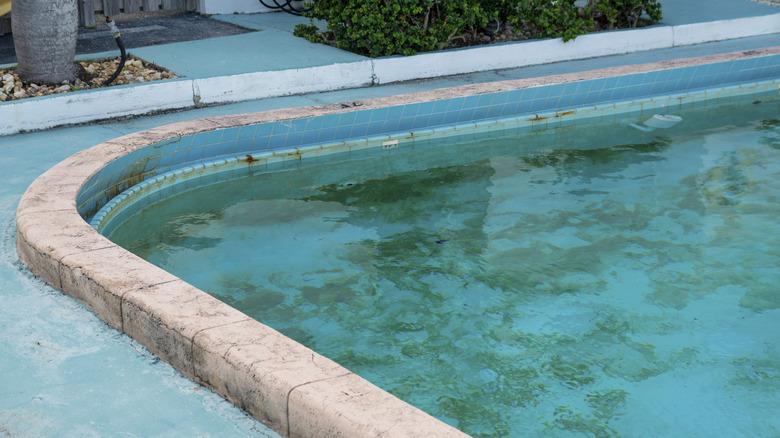Check Your Pool For One Thing If The Walls And Floors Are Slippery And Slimy
We may receive a commission on purchases made from links.
Having a pool can be a great way to relax, spend time with family, or host events, and it can make your outdoor space feel like a luxury getaway. But, when the walls and floor of your swimming area get taken over by a slimy substance, what do you do? CSIRO, Australia's National Science Agency, explains that slippery surfaces are caused by the creation of "biofilm," which is a buildup of algae that covers itself in a slimy matrix for protection. These aquatic organisms appear in pools when the filter that should keep the water circulating is blocked, resulting in stagnant water that allows algae to thrive.
By acquainting yourself with a homeowner's guide to swimming pool parts, you'll learn that cartridges should be regularly cleaned and replaced every couple of years to deter algae growth. Most pool cartridges will be equipped with a pressure gauge that allows you to easily tell when it needs to be cleaned. However, if your pool has recently become slippery or you notice any other signs of unwanted growth, such as discolored or foamy water, then it is probably a good idea to check your pool filter to see if the cartridge needs a good cleaning.
How to deep clean your pool filter
Once your correctly fitted pool filter has been in place for a while, it's likely time to clean the filter cartridge. You first need to turn off the water pump and remove the filter from its housing. This process can sometimes create a vacuum of water, so it is a good idea to either drain the housing completely or open the breather valve to allow air bubbles in. After, you'll want to rinse your cartridge with a garden hose on medium pressure to remove larger debris such as dirt and leaves. Make sure to keep the stream at an angle to avoid damaging the pleats.
The filter will then need to be submerged in a cleaning agent. Household dishwasher liquid can be used for this, though it produces lots of soap bubbles, which means more rinsing is required afterward. A trisodium phosphate powder like this one made by Savogran is recommended as an alternative because it is effective, doesn't create loads of bubbles or foam, and is relatively inexpensive at around $25 for 4.5 pounds. You'll want to use 1 cup of the trisodium for about 5 gallons of water and leave the filter to soak for at least a few hours. Then, once you have removed and rinsed the filters, you may want to soak them in a cleaning acid (like this muriatic acid solution by Klean-Strip) mixture of 1 part to 20 parts water. Leave overnight or until bubbles stop appearing. Importantly, you will need to either neutralize the acid with baking soda or heavily dilute it before pouring it away, as it is a corrosive substance. Finally, you can remove the filters from the hydrochloric mixture, rinse them down immediately, and replace them in your pool. The algae will typically begin to disappear within a couple of days, though using chlorine according to package instructions may be needed to help the process along.

